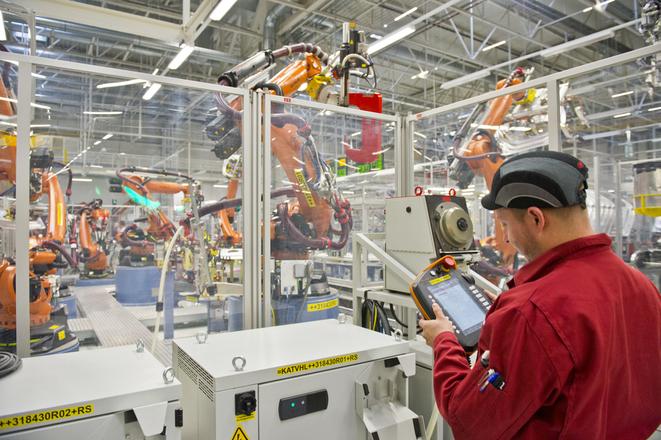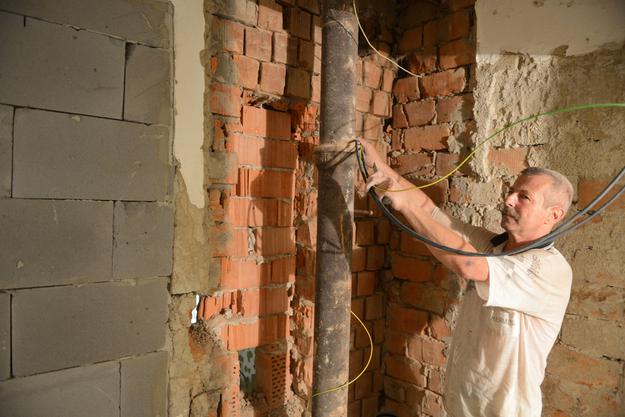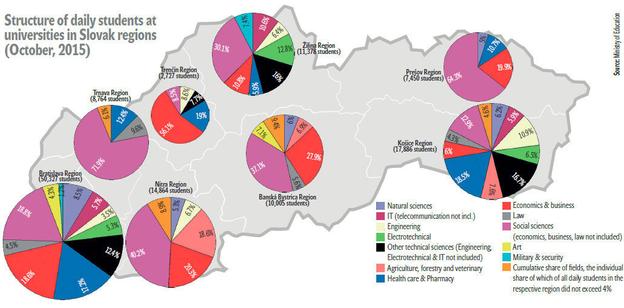More information about the Slovak labour market
Please see our Career & Employment Guide.
This year’s edition was published also thanks to support from the general partner of the guide, the executive search firm - Amrop.
IT companies say they could immediately employ more than 10,000 qualified people and carmakers and their suppliers expect they will need 14,000 new workers over the next three years. Other sectors have also been grumbling about problems in finding young and qualified employees. Health care, for instance, is worrying about ageing doctors and the lack of nurses.
Companies are struggling to hire new workers, either to fill places vacated by those who have retired or for brand new positions as companies expand. At the same time, there are still more than 270,000 people in the labour market without jobs. The reason for this paradox is what has been called a skills gap resulting from a mismatch between what jobseekers can offer and the specific skills demanded by employers. To address this problem, companies – in cooperation with schools – have developed the dual education scheme. They are also calling on the government to make it easier to hire workers from countries that are not members of the EU. The government does not like this idea and instead is pinning its hopes on various requalification schemes, by luring Slovaks working abroad to return, as well as by tightening conditions for the jobless to receive benefits from Slovak social assistance programmes.
“In 2016 the labour market changed and this change was to the benefit of jobseekers,” said Jaroslava Rezlerová, general director of Manpower Group for the Czech Republic and Slovakia.
The unemployment rate has fallen below 9 percent and the current demand for employees significantly exceeds the supply of qualified jobseekers.
“There is a critical lack of suitable workers in large towns and industrial areas… when not only specialised technical professions are among those vacancies to be filled with the most difficulty,” said Rezlerová, adding that it is also basic workers and store clerks that companies are unable to find.
Martin Hošták of the National Union of Employers (RÚZ) sees two reasons behind the lack of available labour. One of them is the revival of the economy that has kept growing at a rate above 3 percent; the other one is that the education system is graduating students in professions that employers are not much interested in.
“The education system does not fulfil the needs of employers and the gap between the demand and supply has been widening,” stated Hošták, as cited by the TASR newswire.
He also pointed out that qualified workers or even just recent school graduates who depart for jobs abroad are a problem as well.
Because solving the problems of the current education system will need more time, employers are asking that it be made easier to hire workers from other countries.
The Labour Ministry and HR experts also say the low motivation of the unemployed to accept a job is another difficulty.
“There are people who simply don’t want to work, others who don’t want to move and change their place of work and others who are below the performance level or qualification expected by the companies, for several reasons,” said Sergio Duarte, general director of Adecco Slovakia.
The government should respond with a more detailed analysis and build a national plan to change the status quo “otherwise companies will not bring their investments here, risking failure on the delivery side”, he added.
Unemployment rate falls
The so-called registered unemployment rate, the rate calculated based on jobseekers able to take a job immediately, was at 8.76 percent in December 2016. It had fallen from 10.39 percent in January 2016, based on data from the Central Office of Labour, Social Affairs and Family (ÚPSVaR).
“The year 2016 was characterised by an increased demand by employers for labour,” said Ján Richter, labour minister, adding that while labour offices offered an average of 38,200 vacancies every month in 2016, the average was only 23,700 a year earlier.
The average registered unemployment rate for all of 2016 was 9.48 percent, down 2.02 percentage points from 2015. In December 2016, the number of jobseekers immediately able to start work was 237,977; this was a decrease of 48,848 year-on-year.
The unemployment rate calculated (based on a different approach) from the total number of 276,131 jobseekers amounted to 10.16 percent in December 2016, down by 2.24 percentage points year-on-year.
While the Bratislava Region continues to register the lowest jobless rate of 4.51 percent, the
Prešov and Banská Bystrica regions keep reporting the highest unemployment rates – 13.91 percent and 12.8 percent in December 2016, respectively, based on ÚPSVaR data.
Data from Slovakia’s Statistics Office also confirm the drop in the jobless rate, reporting 9.5 percent for the third quarter of 2016 compared to 11.5 percent for all of 2015.
The Statistics Office also reported growing overall employment, with its growth accelerating by 0.3 percentage points year-on-year to 2.8 percent to a total of 2.503 million employed people for the third quarter of 2016. The number of the employed people in Slovakia increased during the first three quarters of 2016, reaching historical records.
“We are pleased that especially many people in the age up to 29 years old and the long-term unemployed, i.e. those disadvantaged in the labour market, found jobs,” said Richter, particularly happy by the decrease in the number of long-term unemployed, decreasing from 72,683 to 61,881 in 2016.
The Slovak labour market faces a paradoxical situation when there are still hundreds of thousands of unemployed while employers are struggling to fill vacancies.
“The reason is especially the disadvantageous structure of the unemployed,” stated Luboš Sirota, general director at McROY Group, pointing out that of over 275,000 unemployed at the end of December 2016 almost 85,000 have only basic education, more than 137,000 have been jobless for more than one year and that it is not even possible to find out the previous profession of 160,000 of the unemployed.
Anna Ričányová, branch manager of Grafton Slovakia in Košice, listed other repeated reasons why people fail to get a job, such as unrealistic wage expectations or the inability to speak any foreign language. She added that some of the unemployed are unwilling to move to get a job or to commute.
“Many people do not want to work at all,” said Sirota. “They like the situation when they are ‘sitting at home’ receiving social benefits and the state pays social and health levies for them. They make some money on the side, either legally or illegally.”
The Labour Ministry is addressing this issue by tightening the rules for the unemployed to access the benefits of the social system. For example, the ministry has proposed limiting the possibility of those registered with job offices to work on temporary employment agreements (na dohodu) to 40 days per year. Also, a jobseeker who repeatedly leaves a new job within the first month could not enrol again with the job office, and a person will be excluded from the register if he or she unreasonably refuses to attend requalification programmes or engage in activation work. These proposals still must be passed by parliament but they are expected to become effective as of May 1, 2017. The ministry also wants to increase investments into requalification programmes for the unemployed.
HR experts would also like to see requalification courses better paralleling the needs of the employers as well as better measures to support labour force mobility, for example through support for rental housing as well as through a reduction of the minimum wage and more development of dual education.
Workers from abroad
Importing labour, alongside requalification programmes, is suggested as another way for employers to find necessary skilled labour. For example, the automotive sector expects that it will need about 14,000 people to fill vacancies during the next three years and it wants to bring 4,000 to 5,000 of these workers from abroad. This is because the dual education scheme is just starting and it will take some time until it starts producing newly-qualified workers for the labour market.
“The import of employees is not a systemic way, but it is a way to help those [employers] suffering from the lack of workers so that they have some breathing room,” said Jaroslav Holeček, vice-president of the Slovak Automotive Industry Association (ZAP). “It is a temporary way; what we need to change is the education system.”
ZAP estimates that schools would produce about 4,000 new workers over the following three years.
“We cannot get more from the schools as they do not prepare their students for job occupancy but rather securing papers [i.e. degrees] for them,” stated Holeček.
The car producing sector hopes that it will secure the rest of its needed labour via targeted requalification programmes which could bring 5,000 to 6,000 workers.
In the meantime, carmakers in Slovakia already employ hundreds of foreigners. For example,
Bratislava-based Volkswagen Slovakia has ‘borrowed’ 550 people from its sister company Audi from the Hungarian town of Győr. They are expected to help manufacture cars in Bratislava until about 2018. The Trnava-based PSA Groupe Slovakia, which in January 2017 had about 3,800 employees, was seeking to hire new workers to launch weekend shifts and reported that it employed about 450 foreigners – more than half are from Serbia, mostly with the status of a Slovak living abroad. So even though Serbia is not member of the EU, these individuals do not need any special permission to work in Slovakia.
At the end of 2016, ÚPSVaR reported 35,100 foreigners working in Slovakia. Compared with the end of 2015, this is a significant increase of 9,600 people, a 27 percent jump. Of these foreigners, Romanians were the biggest share with 7,400, an increase by 1,100 from the previous year. Serbians were next with 4,900, an increase of 3,600 from a year earlier and Czechs followed with 4,100 employed in Slovakia, up by 939.
In response to the call of employers to make Slovakia more open to foreign workers, Minister Richter agreed that bringing in foreign labour is a solution, but said that the government would not support a flat, blanket permission.
“I’m saying it very clearly: if a labour office is not able to secure required professions … we are ready to allow arrival of the labour force also from the so-called third countries,” stated Richer in mid-January while admitting that the labour market is unable to fully satisfy the demand of employers for specific professions that are in short supply.
But permission to bring in labour from abroad will be granted only under individual projects and the government does not plan in any way to ease conditions for foreigners outside the EU to come to work in Slovakia.
“We are not interested in the arrival of a cheap labour force that would break down the growth of wages,” Richter said, pointing out the still high number of relatively well-educated people registered with labour offices.
Prime Minister Robert Fico also spoke against more robust import of workers.
“If the phenomenon of the lack of labour led to an increase in wages, this would be a fact we would welcome,” said Fico in late January.
The Fico cabinet has also been pushing for increases in the minimum wage. It currently stands at €435 monthly, up €30 compared with 2016.
Since 2012 the minimum wage has been increased by €107.80. The ambition of Fico’s third cabinet is to hike the minimum wage to €500 by 2020 and Minister Richter can even imagine exceeding this level in 2019.
“Development so far has shown positive impacts on the growth of workers’ incomes, widening the gap between income from work and from social benefits and improving the consumption of households,” Richter told The Slovak Spectator.
Brain drain
Along with the demographic crisis in Slovakia in which its population is expected to age more than all other EU countries, the country is facing a brain drain with a significant portion of its university-educated youth leaving abroad. The Institute for Financial Policy (IFP) think tank at the Finance Ministry estimates that about 300,000 people or almost 5 percent of the total
Slovak population have left Slovakia over the past 15 years. Based on data for 2010 and 2015, more than half of those leaving were under 30 years old. Graduates of medical and technical universities make up the biggest proportion of those leaving. Slovaks emigrate abroad for better remuneration as well as better career prospects.
“Among the five faculties with the biggest percentage of students who leave to work abroad are the three medical faculties,” states the analysis published in January 2017. “Technical faculties – engineers from aeronautics, metallurgical and mechanical engineering faculties in Košice dominate the rest of the chart.”
Slovakia has already launched schemes to lure back educated and experienced people but so far the results are rather limited. In 2016 Slovakia managed to attract only eight experts back home while the plan was to draw back 27 under a state supported scheme. This scheme provides financial support of up to €50,000 for highly-educated experts who decide to return.
Expectations for 2017
HR experts expect that the lack of qualified labour will continue to be a main factor influencing the labour market in 2017.
“The growth of employment and wages will continue; simultaneously the current lack of available labour would deepen,” said Sirota, estimating that this would push up average wages by as much as almost 4 percent in 2017.
Ričányová of Grafton Slovakia expects a high demand for technical professions, reflecting the increasing automation of production, while candidates with non-technical education without knowledge of at least one world language will have problems finding an acceptable job. She added that the interest of employers in hiring people older than 50 years is increasing as these persons are able to work at the most demanding specialised positions.
“Production companies are opening new work positions where expertise and significant experience are needed,” said Ričányová. “Specialists in this age group can get a job within a few days and usually there is no lack of offers for them.”
HR experts believe that attracting enough workers to the labour market as well as hopes that the education system will be able to generate the graduates in the needed professions will be crucial for Slovakia’s future development.
“The unavailability of a skilled labour force may be one of the biggest barriers to the future arrival of foreign investors in Slovakia,” stated Ričányová.






